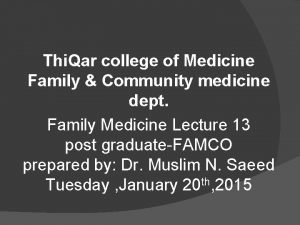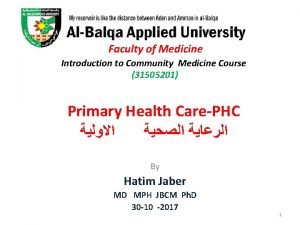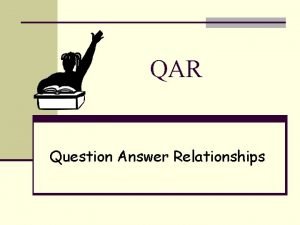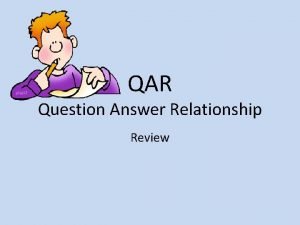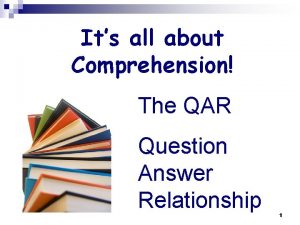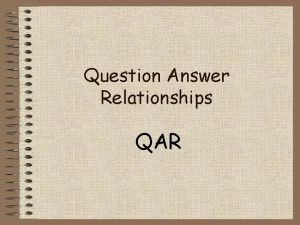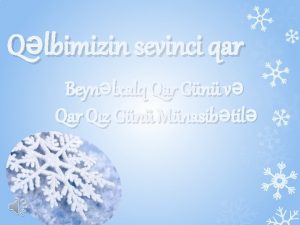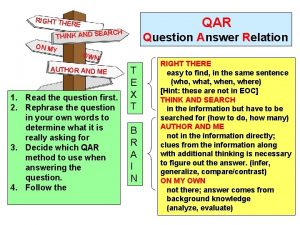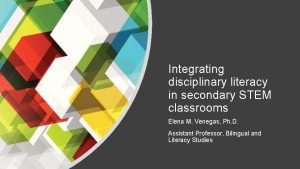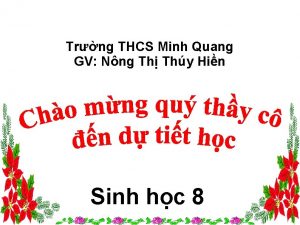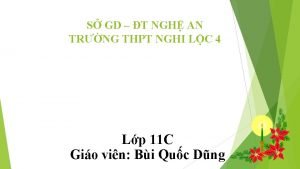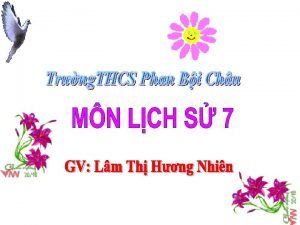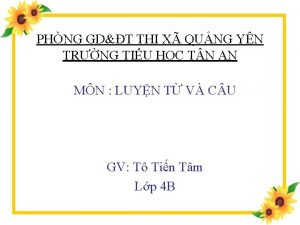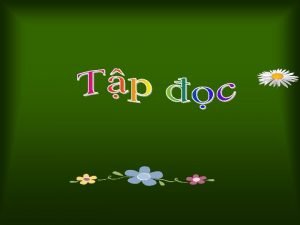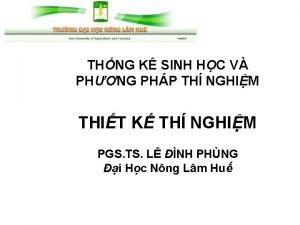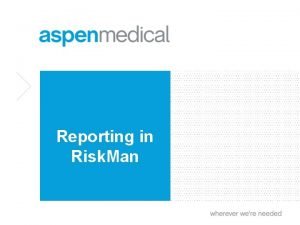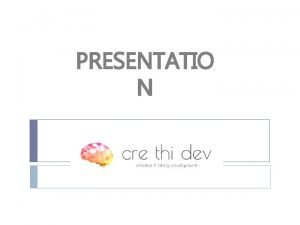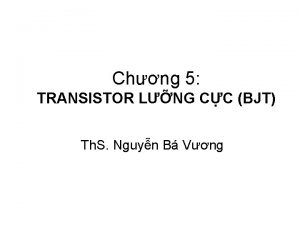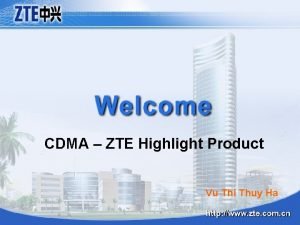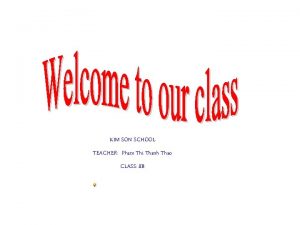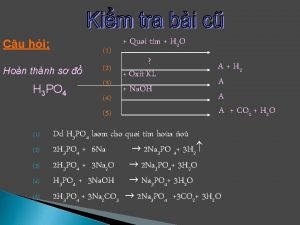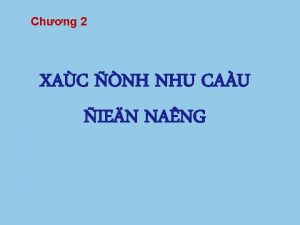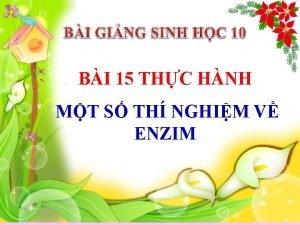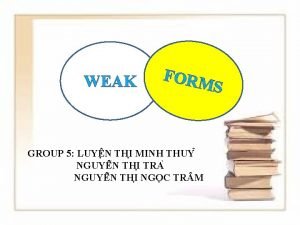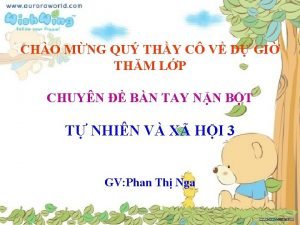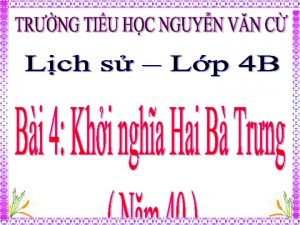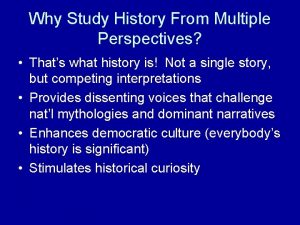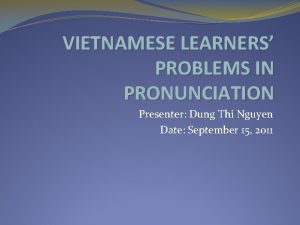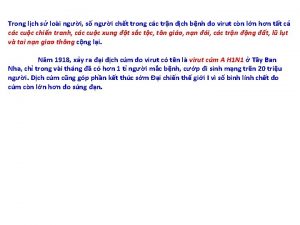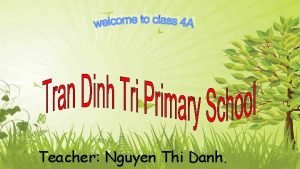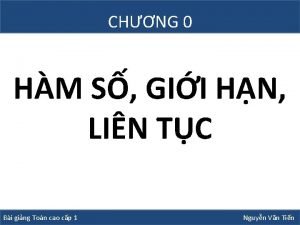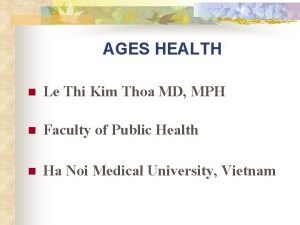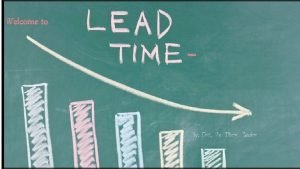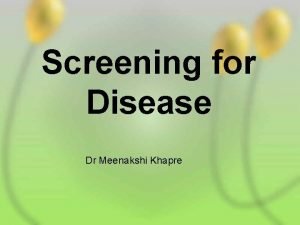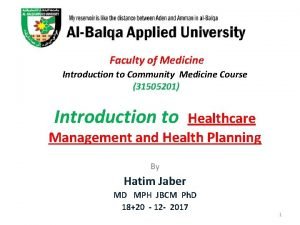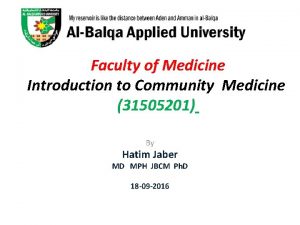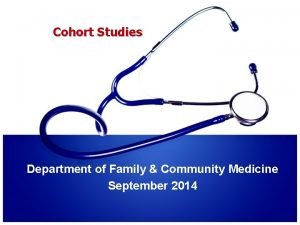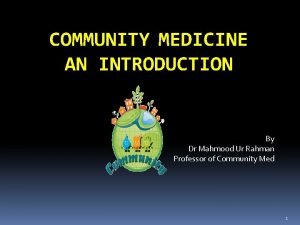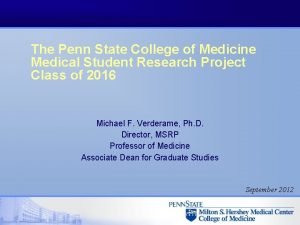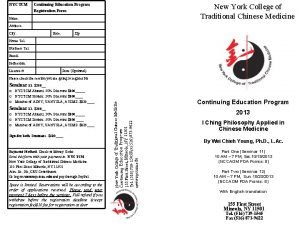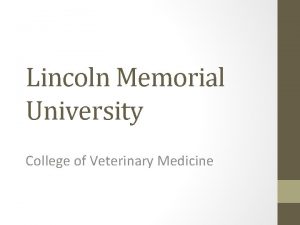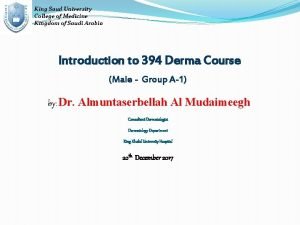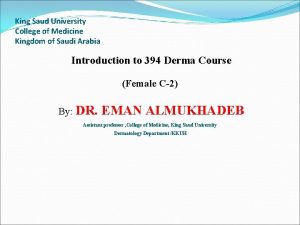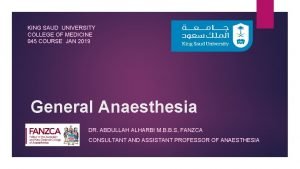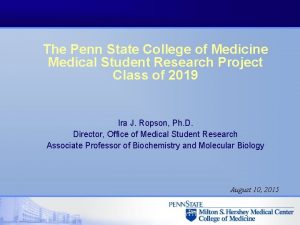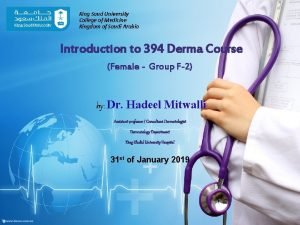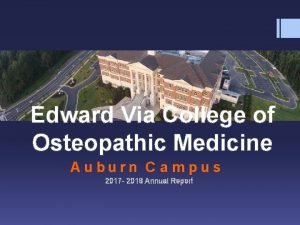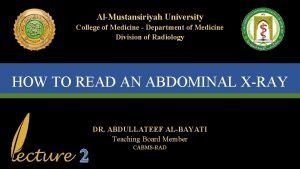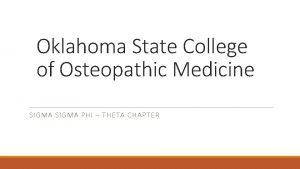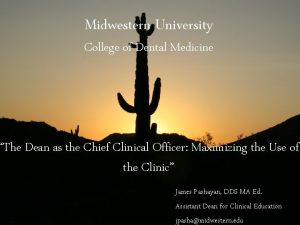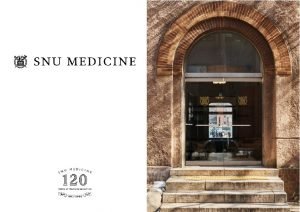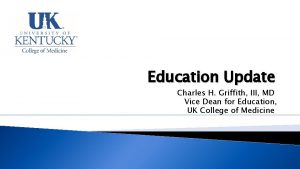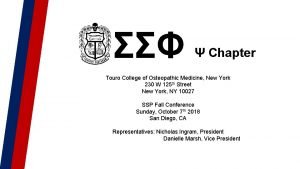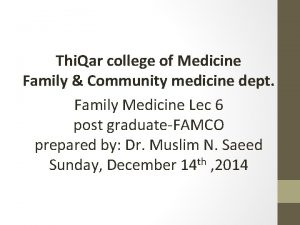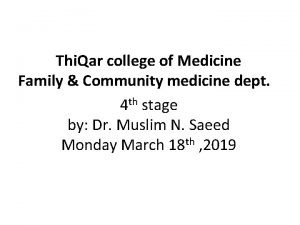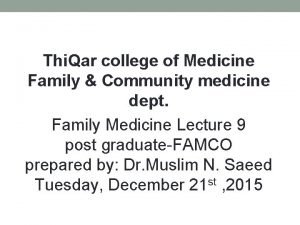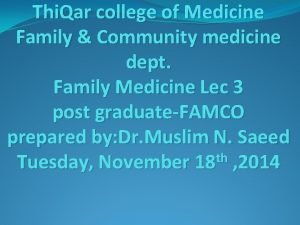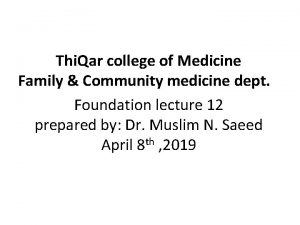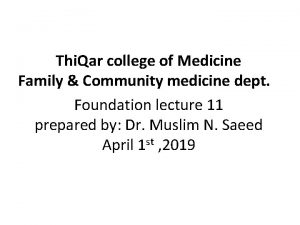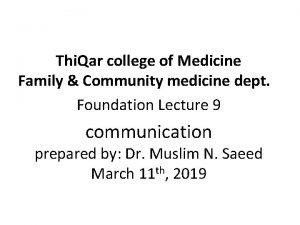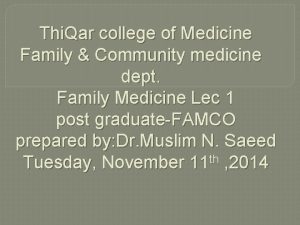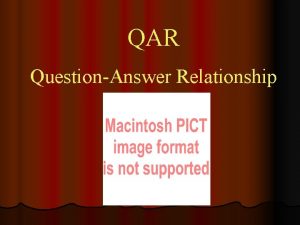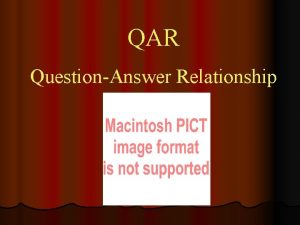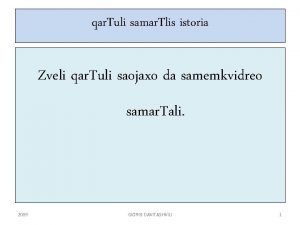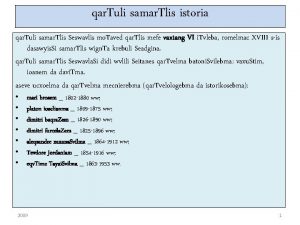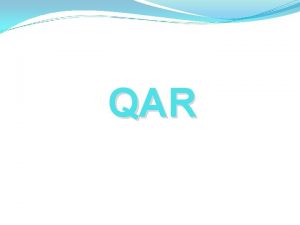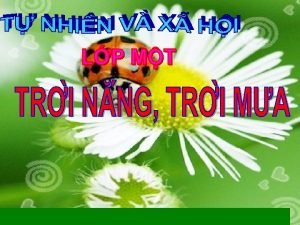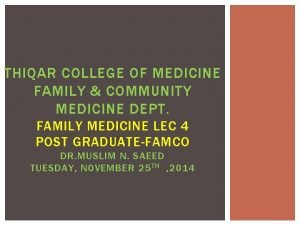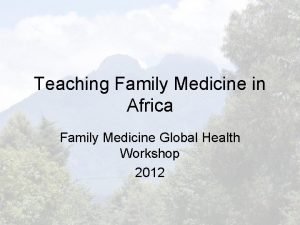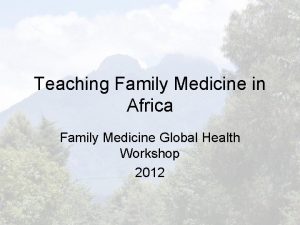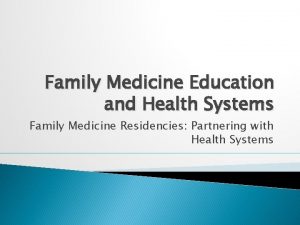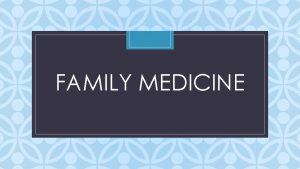Thi Qar college of Medicine Family Community medicine



























































- Slides: 59

Thi. Qar college of Medicine Family & Community medicine dept. Family Medicine Lecture 14 post graduate-FAMCO prepared by: Dr. Muslim N. Saeed Tuesday , January 27 th, 2015

Complementary and Alternative Medicine: Integration into Primary Care

• Terms and definitions that describe CAM are diverse and evolving. • Integrative medicine combines CAM and conventional medicine. Alternative medicine is used in place of conventional medicine. Complementary medicine is used together with conventional medicine. Integrative medicine combines mainstream medical therapies and CAM therapies for which there is some high-quality scientific evidence of safety and effectiveness.

Definition Complementary and alternative medicine is a group of diverse medical and health care systems, practices, and products that are not considered part of conventional medicine. Although some scientific evidence exists, the list of what is considered to be CAM changes continually as therapies that are proved to be safe and effective become adopted into conventional health care and as new approaches to health care emerge.

Frequently used synonyms of alternative medicine Complementary and alternative (CAM) medicine nal medicine Indigenous medicine Fringe medicine l medicine Unorthodox medicine

There is no alternative to the proper conventional medical practice. However, it can complement conventional medicine through relieving pain and other symptoms, alleviating mood, improving the quality of life or possibly enhancing healing of disease. That is why the term "complementary medicine" is preferred.

The field of family medicine has taken the lead and is currently pioneering work bringing complementary and alternative medicine (CAM) and integrative medicine into residency training and clinical care. Complementary and alternative medicine is based on multiple healing traditions practiced long before conventional medicine.

The World Health Organisation (WHO) has paid a clear attention in CAM and introduced traditional medicine in its programs in 1976, which became a part of the recommendations of the conference on primary healthcare in Alma Ata in 1978 to involve traditional practitioners within the health team after training them socially and technically. The Eastern Mediterranean Regional Office of the WHO held meeting in 1993 to prepare guidelines for national policies of CAM. An advisory committee came out of this meeting concluded in 1995 that scientific evaluation of some of these traditional practices should be encouraged. Countries differ in the extent of using such a diverse CAM methods. In Britain, for example, acupuncture, chiropractic, osteopathy, herbal medicines, and hypnosis constitute around 75% of the CAM therapies practiced.



In the developed world, in contrast to developing and poor countries, many CAM practices (e. g. acupuncture, chiropractic, homeopathy…) are in the hands of physicians or authorized healthcare professionals. In the United States, half of the alternative practitioners are physicians. One study in the south of Iraq showed that traditional medical practices, apart from faith healing, are limited to herbal medicine and apothecaries with experience in traditional prescriptions, primitive types of osteopathy and chiropractic, ear dissection, blood cupping and the use of honey for treatment of diseases. Acupuncture has been practiced by an anesthetist to treat pain and primitively by old ladies for local treatment of arthritis.

In the United States , over the past few decades, alternative medicine has become a more recognized entity within conventional medicine. Because of the public’s growing use of CAM, the National Institutes of Health (NIH) created an Office of Alternative Medicine (OAM) in 1992. Because of Americans’ ongoing and increasing use of CAM, the OAM was expanded to the National Center for Complementary and Alternative Medicine NCCAM’s free website contains a wealth of information, including the following definitions: Complementary and alternative medicine is a group of diverse medical and health care systems, practices, and products that are not considered part of conventional medicine. Although some scientific evidence exists, the list of what is considered to be CAM changes continually as therapies that are proved to be safe and effective become adopted into conventional health care and as new approaches to health care emerge.

The NCCAM further classifies CAM into five categories, or domains. Examples of alternative or whole medical systems include homeopathy, naturopathy, and Ayurveda.


The (NCCAM) groups complementary and alternative medicine (CAM) practices into five domains, recognizing that there can be some overlap among them. 1 - Biologically based therapies use substances found in nature, such as herbs, special diets, or vitamins (in doses outside those used in conventional medicine). 2 - Energy therapies involve the use of energy fields, such as magnetic fields or bio-fields (i. e. , energy fields that some believe surround and penetrate the human body). 3 - Manipulative and body-based methods are based on manipulation or movement of one or more body parts. 4 - Mind-body medicine uses a variety of techniques designed to enhance the mind’s ability to affect bodily function and symptoms. 5 - Alternative or whole medical systems are built on complete systems of theory and practice.

Acupuncture is to treat patients by insertion of needles at particular points in the body (joined together as meridians). These needles are stimulated either through manual manipulation or through passing a weak electrical current.


Acupuncture is now practiced in different countries around the world with the difference that in western countries, it is accepted as a method to relieve some types of pain e. g. neck pain and also to treat postoperative nausea and vomiting; its effect in other conditions is, probably, no more than a placebo. While in China, it is used to treat pain as well as different types of diseases.

Examination of the tongue and the pulse are among the main diagnostic methods in traditional Chinese medicine. The surface of the tongue is believed to contain a map of the entire body, and is used to determine acupuncture points to manipulate. The mechanism through which acupuncture works is thought, in modern medicine, to involve the body's pain reduction system with increased release of endorphins, serotonin, norepinephrine or gamma-aminobutyric acid.

The risk of acupuncture needles penetrating the skin is rare among patients treated by trained practitioner. The adverse effects of acupuncture include slight hemorrhage, hematoma, dizziness, bacterial infection, hepatitis B, nerve injury and death can occur due to pneumothorax. Acupressure is applying pressure to acupuncture points e. g. through non-penetrating needles.


Homeopathy is a form of alternative medicine in which practitioners treat patients using highly diluted preparations of substances. These substances can cause symptoms similar to that of the disease being treated when given to healthy people. Thus, the first principle of homeopathy is to let "like" be cured by "like" or what is called "the law of similars" (this law is not a true scientific law).

Homeopathic remedies can be derived from animal, plant, mineral and synthetic substances e. g. arsenic oxide, sodium chloride, venom of snake, opium and thyroid hormones. This extends to cover pathological products of diseases such as blood, tissues and fecal, urinary and respiratory discharges.

Chiropractic is a form of alternative medicine that aims to treat and prevent mechanical disorders of the musculoskeletal system especially the spine. One of the principles on which it is based is that these mechanical disorders affect general health via the nervous system. It is believed that spine and health are related in a fundamental way and that this relationship is mediated through the nervous system. Vertebral misalignments (also called vertebral subluxations) are thought to interfere with the body's function and its ability to heal itself. Since nerves, that carry impulses outward to different organs in the body and sensations inward, are connected to the spinal cord in between the vertebrae, manipulation of the vertebral column is expected to affect diseases of organs far away from the spine.

Spinal manipulation (spinal adjustment) is the most common treatment used in chiropractic care. Many other procedures are used by chiropractors for treatment of the spine, other joints and tissues, and general health issues. These procedures include physical fitness promotion, postural advice, relaxation and stress reduction … etc

Chiropractic overlaps with several other manipulative therapy professions including massage therapy, osteopathy, physical therapy and sport medicine. Chiropractic has gained greater acceptance among medical physicians and health plans. It is considered the largest alternative profession behind medicine and dentistry in the U. S. Recently, New Mexico became the first state in the U. S. to allow trained chiropractors to prescribe certain medications. Chiropractic effectiveness is still controversial. Yet, it has been found effective in treatment of low back pain, neck pain, some kinds of headaches and a number of extremity joint conditions. In general, chiropractic is relatively safe if practiced skillfully. Absolute contraindications to spinal manipulation therapy are conditions that should not be manipulated such as rheumatoid arthritis. Relative contraindications include osteoporosis. Adverse effects include new or worsening of pain in the affected region. Rarely, permanent disability or even death can result from spinal manipulation particularly upper spine.

Osteopath (Osteopathic Medicine) The principles of osteopathy are based on: 1. The body is an integrated unit of mind, body and spirit. 2. The body has inherent capacity to defend and repair itself. 3. The structure (anatomy) and function (physiology) are inter-related. Practitioners in osteopathic medicine are either manual therapy osteopaths or full scope medical practice osteopathic physicians (in the U. S. , nearly all osteopaths are physicians).

There are many treatment techniques, both active and passive e. g. the person may voluntarily perform an osteopathic motion or the patient refrains from voluntary muscle contraction. Examples of osteopathic techniques include articulatory technique, balanced ligamentous tension, cranio-sacral therapy, counter-strain, thrust technique, myo-fascial release and soft tissue therapy techniques. Many osteopaths also manage or co-manage organic conditions such as asthma, menstrual pain, and pulmonary infections.

Another term, holistic medicine, also describes these practices and philosophy. “Holistic medicine is the art and science of healing that addresses care of the whole person—body, mind, and spirit. The practice of holistic medicine integrates conventional and complementary therapies to promote optimal health and to prevent and treat disease by addressing contributing factors”.

In 1981, the nursing profession, guided by a group of nurses dedicated to bringing the concepts of holism to every arena of nursing practice, founded the American Holistic Nursing Association (AHNA). Integrative medicine, a term brought into popular use by Andrew Weil, Integrative medicine is healing oriented and emphasizes the centrality of the doctor-patient relationship. It focuses on the least invasive, least toxic, and least costly methods to help facilitate health by integrating allopathic and complementary therapies.

These are based on an understanding of the physical, emotional, psychologic, and spiritual aspects of the individual. Family physicians know this to be true. They practice with the intention to care for the whole patient within the context of a continuous healing relationship and interplay of family, community, and environment.

Complementary and Alternative Medicine Use in the 1990 s • Almost 40% of U. S. adults and 12% of children use CAM therapies. • The number of adult Americans using CAM rose by 38% between 1990 and 1997 and has remained stable between 2002 and 2007. • CAM is used more by women, by those with higher levels of education and income, and by those who were recently hospitalized. • Most patients do not disclose CAM use to their physicians. • Most patients use CAM and conventional care together.

Complementary and Alternative Medicine Use in the 21 st Century Data on the U. S. population’s use of CAM was collected in 2002 and 2007:









Integrating Complementary and Alternative Medicine into Practice • Nutrition, mind-body medicine, and spirituality are core elements of integrative medicine practice. • Strong evidence supports mind-body medicine for coronary artery disease, low back pain, and headache. • Acupuncture is a safe and efficacious adjunctive treatment for several musculoskeletal conditions. • Energy medicine researchers use current technologies to explore the frontiers of CAM.

Core Elements of Integrative Medicine Nutrition, mind-body medicine, and spirituality are considered core elements of an integrative medicine approach and often are applied during patient consultation. These elements also tend to be cost-effective and patient empowering. Considered the foundation of good health and enhanced healing, nutritional principles are key elements in most treatment plans.

The adage “food is medicine” is becoming ever more important as the United States faces impending epidemics of diabetes and obesity. There are various recommendations for the prevention and treatment of obesity, mood disorders, heart disease, diabetes, chronic pain, and inflammation.

Omega-3 fatty acids, antioxidants, medicinal seasonings, soy, chocolate, and tea are all considered. For example, green tea offers a variety of health benefits, with emerging evidence for prevention of cancer, stroke, and cardiovascular disease. A particular aspect of nutrition that has received increasing attention for its value in lessening inflammation is that of fish oil (i. e. , omega-6 and omega-3 fatty acids). Omega-3 fatty acids consist of eicosapentaenoic acid (EPA) and docosahexaenoic acid (DHA) and are mostly found in fatty fish, such as herring and salmon. Because inflammation plays a role in several common conditions, such as cardiovascular disease, asthma, arthritis, psoriasis, and inflammatory bowel disease, research has explored the role of omega-3 fatty acids in reducing symptoms and improving outcomes.

Practical applications for recommending fish oil in the primary care setting included the following: 1. The American Heart Association recommends 1 gram (g) per day for all patients with documented coronary artery disease through diet or through supplementation. 2. For patients with mild or persistent hypertriglyceridemia, use of 2 to 4 g per day of fish oil may lower levels by 20% to 50% to reach ATP III goals. 3. For those with rheumatoid arthritis, doses of 2. 6 to 6 g per day for at least 8 to 12 weeks are optimal and may reduce or eliminate nonsteroidal anti-inflammatory drug (NSAID) use.

Monitoring for clinical bleeding and for low-density lipoprotein (LDL) cholesterol and glycemic response should be considered for patients taking doses higher than 3 g/day, especially if they are diabetic. Unfortunately, because our waters are polluted with heavy metals, avoiding fish known to have high methyl mercury levels (especially by women who are pregnant and of childbearing age) is an important precaution when discussing fish oil use with patients.

Mind-Body Medicine The area of CAM with perhaps the most extensive research base is mind-body medicine, which encompasses a diverse array of practices that overlap many traditions and whole systems of care. Astin and colleagues (2003) concluded, “There is now considerable evidence that an array of mind-body therapies can be used as effective adjuncts to conventional medical treatment for a number of common clinical conditions. ” They found strong evidence to support mind-body approaches in the treatment of low back pain, coronary artery disease, headache, insomnia, preparing for surgical procedures, and in the management of disease-related symptoms of cancer, arthritis, and urinary incontinence.

Mind-body medicine approaches may enhance healing and optimize health. They may be recommended to most patients for health maintenance and disease management and could easily be incorporated through group visits or health coaches. a well-known and well-studied mind-body technique called mindfulness-based stress reduction (MBSR) and includes a short audio sample of mindful breath work.

Spirituality encompasses the feelings, thoughts, experiences, and behaviors that arise from a search for that which is generally considered sacred or holy. Religion is the codified and ritualized beliefs and behaviors of those involved in spirituality, usually taking place within a community of likeminded individuals.

taking a spiritual history is essential to a comprehensive and culturally sensitive medical consultation, a spiritual history helps elucidate how spiritual beliefs or religious practices may impact health and health-related choices. Such discussions may be most relevant during times of a new diagnosis, loss of a loved one, onset of depression, or terminal illness. Various models have been suggested as guides to taking the spiritual history.

Acupuncture, Yoga, and Homeopathic Remedies Three areas of CAM are most likely to be encountered in the family physician’s office. acupuncture within traditional Chinese medicine (TCM), yoga as a part of Ayurveda, and homeopathic remedies as the mainstay of homeopathy.

Acupuncture efficacious as an adjunctive therapy in osteoarthritis of the knee and as a complement to standard therapy for the debilitating effect of pelvic girdle pain during pregnancy, reviews have shown that acupuncture benefits patients with chronic low back pain, neck pain, and headache(migraine and tension). Acupuncture effectively relieves chronic low back pain.

clear evidence shows that acupuncture is efficacious for adult postoperative and chemotherapy nausea and vomiting and for postoperative dental pain. Also reported that acupuncture should be considered a useful adjunct for addiction, stroke rehabilitation, osteoarthritis, headache, low back pain, tennis elbow, menstrual cramps, carpal tunnel, and fibromyalgia.

Yoga, a widely popular and rapidly increasing CAM Practice. The original goal of practicing these postures was to purify and prepare the body for higher states of consciousness. Hatha yoga, along with other types of movement therapies, has many different styles and is the most popular form taught and practiced in the today. Because most yoga instructors are not medical professionals, it is recommended to refer a patient to a teacher with several years’ experience.

A study concluded that an integrated approach to yoga during pregnancy was safe and that it improved birth weight and decreased preterm labor and intrauterine growth retardation with no complications. Those with chronic low back pain who participated in a 24 -week trial of yoga twice a week experienced decreased levels of pain, functional disability, and depression.

The most controversial of CAM therapies, homeopathy founded by the German physician Samuel Hahnemann (1755– 1843), homeopathy is still widely accepted and practiced in Europe. Dr. Hahnemann developed the Principle of Similars, in which “like cures like” based on his medical translation work and personal experience of malaria symptoms after taking Cinchona bark, which was then the treatment for the disease.

the evidence on the effectiveness of homeopathy for specific clinical conditions is scant, is of uneven quality, and is generally poorer quality than research done in allopathic medicine.

EVIDENCE-BASED SUMMARY 1. Fish oil supplementation can benefit heart health, hypertriglyceridemia, and rheumatoid arthritis. 2. Acupuncture should be considered as a treatment option for common painful conditions such as chronic low back pain , neck pain and headache (migraine, tension). 3. Green tea is associated with decreased risk of stroke and cardiovascular diseases and may help prevent cancer of the breast, gastrointestinal tract , and prostate. 4. Yoga reduces functional disability, pain, and depression in people with chronic low back pain. 5. Mindful communication may improve physician well-being and attitudes associated with patient-centered care.
 Types of family in community medicine
Types of family in community medicine Principles of primary care
Principles of primary care Duke medicine grand rounds
Duke medicine grand rounds Qar questions
Qar questions Incy wincy spider questions and answers
Incy wincy spider questions and answers The qar
The qar Qar test
Qar test Keçdi dəniz aşdı dağ
Keçdi dəniz aşdı dağ Qar visuals
Qar visuals Qar visuals
Qar visuals Tế bào thụ cảm thị giác
Tế bào thụ cảm thị giác Một học sinh cận thị có các điểm cc cv
Một học sinh cận thị có các điểm cc cv Bé thì chăn nghé chăn trâu
Bé thì chăn nghé chăn trâu Bớt đầu thì bé nhất nhà
Bớt đầu thì bé nhất nhà Mode địa chỉ tức thì là mode
Mode địa chỉ tức thì là mode Nguyễn thị cẩm châu
Nguyễn thị cẩm châu Các kiểu bố trí thí nghiệm
Các kiểu bố trí thí nghiệm Saverisk login
Saverisk login Creative thi
Creative thi Ic=βib
Ic=βib Vu thi thuy
Vu thi thuy Pham thi thanh thao
Pham thi thanh thao Cu + hi
Cu + hi đồ thị phụ tải
đồ thị phụ tải Nguyễn thị diễm my
Nguyễn thị diễm my Thực hành một số thí nghiệm về enzim
Thực hành một số thí nghiệm về enzim Dinh thi lan
Dinh thi lan Weak and strong forms exercises
Weak and strong forms exercises Lan nguyen thi
Lan nguyen thi Phan thị nga
Phan thị nga Bắc bộ
Bắc bộ Tran thi gung
Tran thi gung Thi pronunciation
Thi pronunciation Ivanopxki
Ivanopxki Uf canvs
Uf canvs đồ thị hàm arctan
đồ thị hàm arctan Lạy chúa này con xin đến để thực thi ý ngài
Lạy chúa này con xin đến để thực thi ý ngài Le thi kim thoa
Le thi kim thoa Lt lead time
Lt lead time Lead time in community medicine
Lead time in community medicine Minus desk in school
Minus desk in school Introduction to community medicine
Introduction to community medicine Introduction to community medicine
Introduction to community medicine Cohort study community medicine
Cohort study community medicine Seqs community medicine
Seqs community medicine Penn state college of medicine msr
Penn state college of medicine msr New york college of traditional chinese medicine manhattan
New york college of traditional chinese medicine manhattan Lincoln memorial university college of veterinary medicine
Lincoln memorial university college of veterinary medicine King saud university college of medicine
King saud university college of medicine King saud university college of medicine
King saud university college of medicine Prodofol
Prodofol Penn state college of medicine msr
Penn state college of medicine msr King saud university college of medicine
King saud university college of medicine Edward via college of osteopathic medicine auburn
Edward via college of osteopathic medicine auburn Enteroclysis vs barium follow-through
Enteroclysis vs barium follow-through Oklahoma state college of osteopathic medicine
Oklahoma state college of osteopathic medicine Midwestern university college of dental medicine
Midwestern university college of dental medicine Seoul national university medical school
Seoul national university medical school University of kentucky college of medicine
University of kentucky college of medicine σσφ
σσφ
